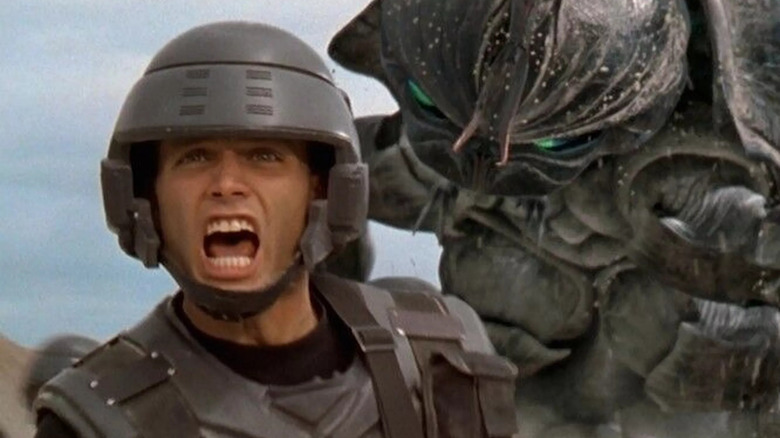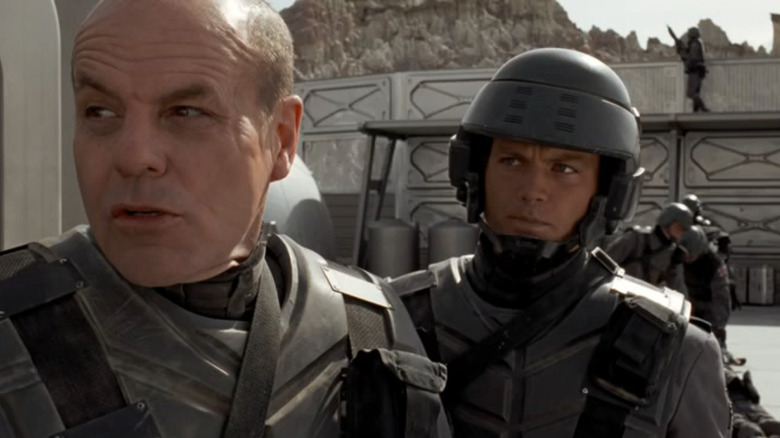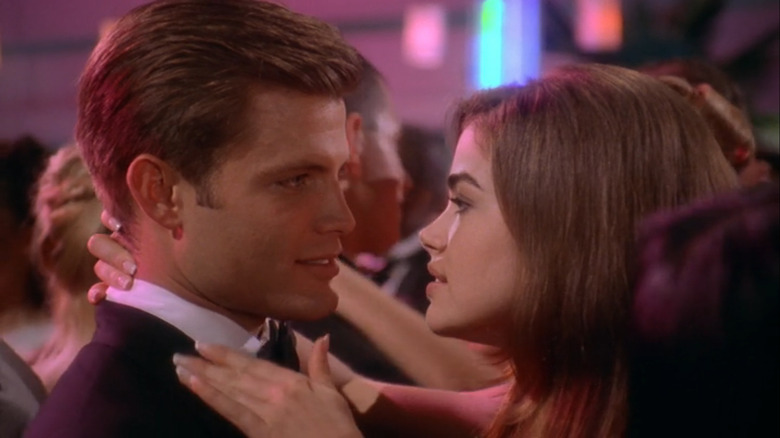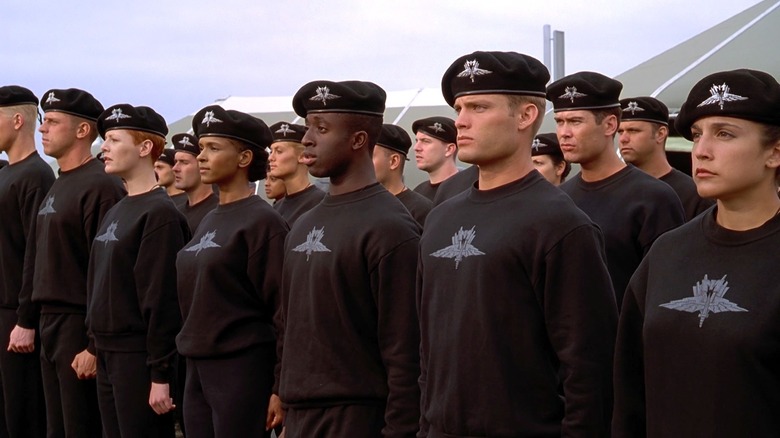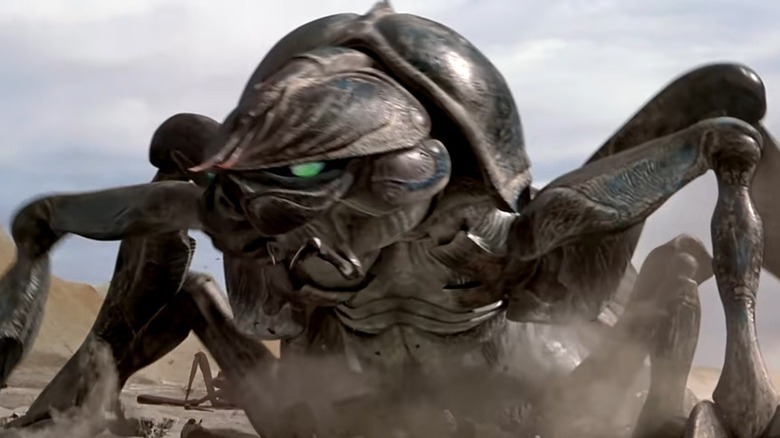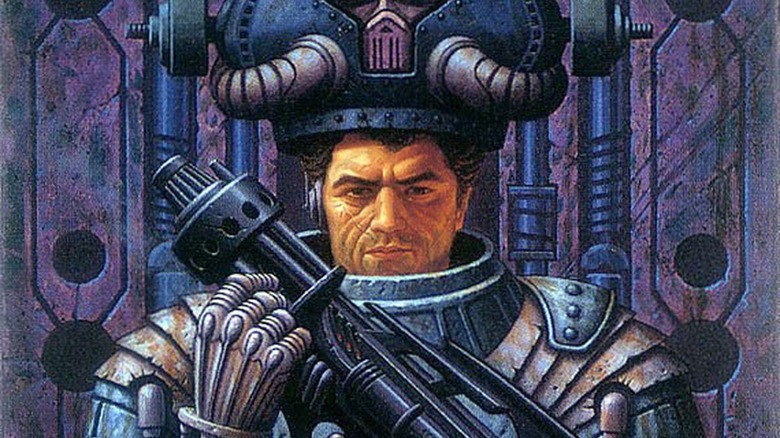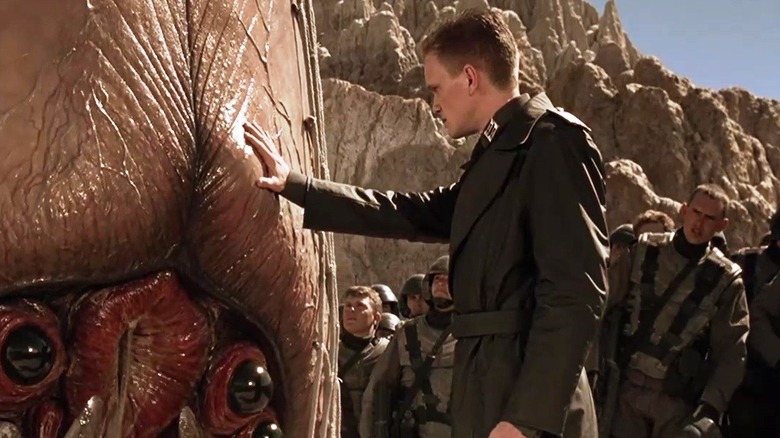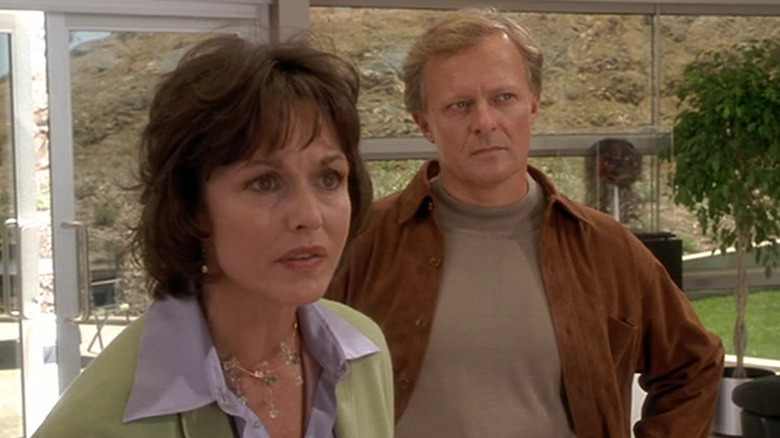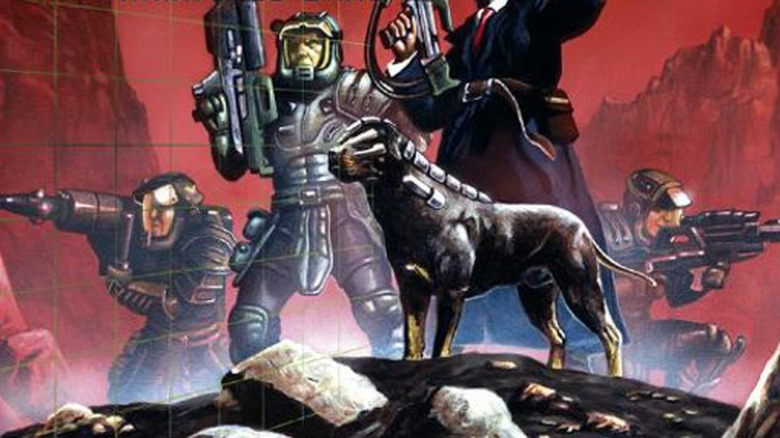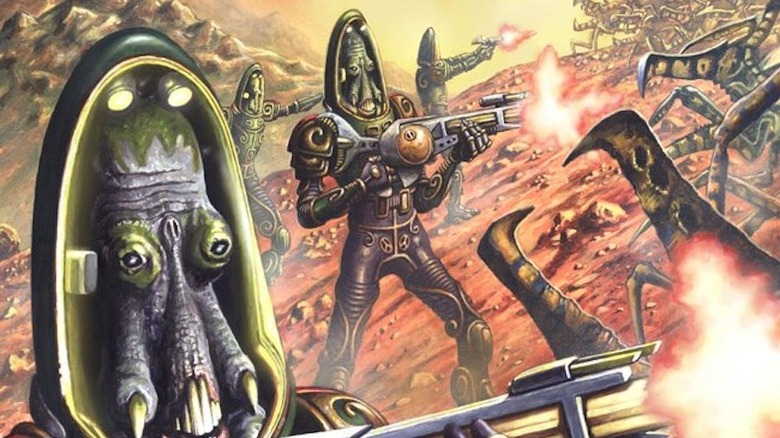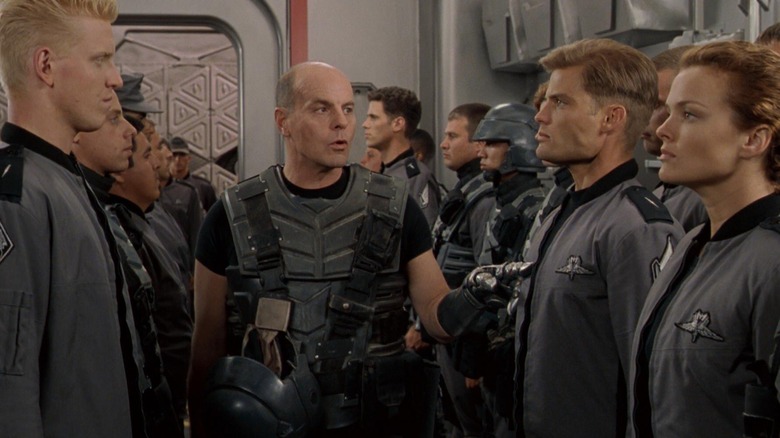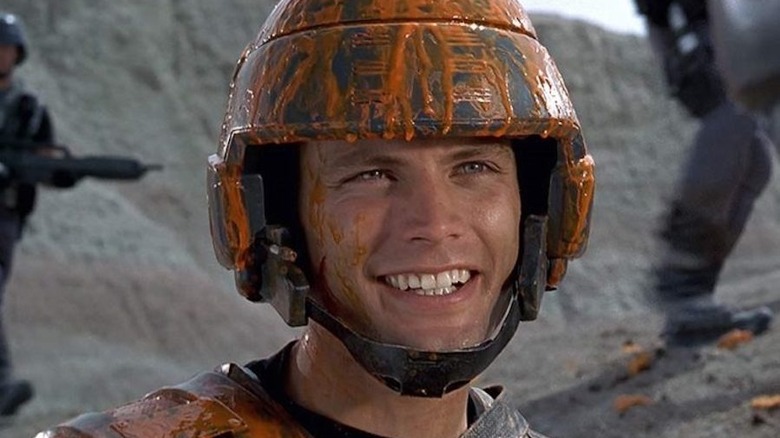The Biggest Differences Between Starship Troopers And The Book
The 1990s brought us some of the best sci-fi action movies of all time, from "Terminator 2" to "Independence Day" to "The Matrix." But smack dab in the middle of them all was a futuristic space marine action flick called "Starship Troopers." Directed by Paul Verhoeven, it centers on Johnny Rico (Casper Van Dien), who joins up with his friends Carl (Neil Patrick Harris) and Dizzy (Dina Meyer) and his girlfriend Carmen (Denise Richards) to serve in the Terran Federation military. But while they're in training, interstellar war breaks out against a race of insidious alien bugs.
Loved by fans for its over-the-top action and tongue-in-cheek tone, "Starship Troopers" has become a bona fide cult favorite. It's spawned a string of direct-to-DVD sequels, an animated series, comic books, video games, and RPGs that have kept the story going. But some fans may not even realize that "Starship Troopers" is based on a novel from the 1950s by sci-fi luminary Robert Heinlein. Originally titled "Starship Soldier" when it was first published in two parts in "The Magazine of Fantasy & Science Fiction," it was an instant classic. Fans of the film might be even more surprised to learn just how different the book is from the film, as Verhoeven and screenwriter Ed Neumeier radically refashioned the story for the big screen.
If you wanna live forever, arm up and prepare for an all-out assault as we dig into the biggest differences between "Starship Troopers" and Heinlein's classic novel.
Military propaganda vs. anti-war satire
To this day, some critics and audiences still don't quite get "Starship Troopers," sometimes taking it for genuine pro-military propaganda when in fact it's a tongue-in-cheek satire. Labeled "one of the most misunderstood movies ever" by The Atlantic, it seems many failed to notice how the film's comically exaggerated style was a part of its takedown of fascist authoritarianism. But some of the confusion is a little more understandable when one is more acquainted with the book, which is wildly different in tone and has a more sincere pro-military message.
For those familiar with the movie, it might raise an eyebrow to learn that the combat action only plays a small role in the book, with Heinlein much more interested in discussion of moral philosophy, critiques of early 20th century liberalism, individual rights, and responsibility to the collective. The book is also filled to the brim with minutiae and detail, exploring the command structure and tactics of the Mobile Infantry, making it often feel like a technical manual. But the book is indeed overtly political, with the Bugs described in no uncertain terms as representing communism, and several key passages muse on the benefits of authoritarianism over a free democracy.
Though some critics didn't see it at the time, the film is an attempt by director Paul Verhoeven to criticize Heinlein's belief in a government ostensibly run by the military. For those reading the book for its right wing political message, the film's clear satire likely ruffled more than a few feathers, assuming they noticed it.
The romance was invented for the movie
In Paul Verhoeven's 1997 film, the romantic love quadrangle involving Rico, Carmen, Dizzy, and Zander sits at the center of the story. In fact, one might reasonably argue that the movie is as much about Rico's attempt to find love as it is about Earth's battle with a race of interstellar insects. But in the original novel there's no such romance to speak of, as the four-sided affair among the young heartthrobs was entirely invented for the film.
In fact, the character of Zander doesn't exist in the original text, while Carmen is mentioned only a handful of times. Dizzy, meanwhile, only appears on a single page, and is dead when he first appears. And yes, you read that correctly — in the novel, Dizzy Flores is a man, a compatriot of Rico's in the Mobile Infantry who "buys it" before the story has barely begun. As for Rico, his relationship with Carmen is more like an unrequited schoolboy crush than anything else: Carmen is described as a woman who will never settle down and is happy to play the field, and they're merely good friends.
In the film it's quite the opposite, as Rico and Carmen's relationship is a major plot point, motivating him for much of the story, while their break-up makes him rethink his service entirely. In the book, it's the court-martial of another soldier in boot camp that makes him reassess. Carmen only re-enters the story much later, when they catch up while on leave and Rico is surprised to see her with a shaved head.
The book is more about training than the war
Over the years, "Starship Troopers" has built a fervent fan following for its thrilling space marine action. But while the movie spends less than 20 minutes in boot camp training for the Mobile Infantry, and more than an hour at war with the Arachnids, it's actually the reverse in the book. There, more than half of the story is set during Rico's time in training, and covers with great detail his journey from fresh-faced recruit to battle-hardened veteran soldier. In fact, instructor Zim (Clancy Brown in the film) is one of the few major characters in the book besides Rico.
Compare the movie with the book and you'll find that many of the boot camp scenes from Heinlein's novel are translated into the film, such as Zim's challenging new recruits to a fight, or a soldier questioning him on why they need to learn to use a knife. But these sequences play out very differently in the book, where they often spark lengthy philosophical discussions on the nature of war and power. We get far more insight into Rico's personal journey, the importance his service holds to him, and the camaraderie he feels towards his fellow soldiers.
When war does break out, it's not nearly as dramatic in the book. It happens mostly off-page, with Rico simply remarking that Earth had gone from "peacetime" to "state of emergency" to "war" while he had been in training. He even notes how unremarkable the change had been from his perspective.
The Arachnids are very different
In "Starship Troopers," the Arachnids are a dangerous, unstoppable foe, a race of primitive insect warriors who can tear through an entire Earth army with ease. They're an alien race that humans are intimately familiar with, as we see Rico and his classmates dissecting them in school, and news footage tells us there has been a fragile peace for years. But it's also hinted at more than once that their attack on Buenos Aires — the strike that triggered the war — was actually in response to humans intruding on their territory.
The Bugs we meet in Heinlein's book, however, are markedly different. In addition to being more human-sized, they're also known to be highly intelligent and technologically advanced, using traditional sci-fi weapons like laser rifles, with their own starships and even cities on their home planet of Klendathu. When they strike Buenos Aires, it's a clear act of aggression, and there's never any suggestion that the Terran Federation might have in any way provoked a retaliatory assault. The Bugs are evil, they are the enemy, they are a dangerous hive mind — hence the socialist allegory — and they are a clear and present mortal threat to all human life.
It's even said in the book that Bugs can breed faster than the Mobile Infantry can kill them, able to produce new soldiers almost on a whim. Like the movie, however, their soldiers are nearly mindless workers, taking command instruction from the brain bugs that lurk beneath the surface of the planet.
The mobile infantry use giant mech suits
In one of the most notable changes from the novel, the movie version of "Starship Troopers" eliminated a key component of the space marine tech: their hulking mech suits. A signature element of the book, these suits encase each soldier like a mobile tank, and much of the novel goes into lengthy detail about their capabilities, benefits, and drawbacks. In fact, they're such a major part of the story that they appear on the cover of practically every edition of the novel that's been published over the years
In addition, Rico and his fellow Roughnecks don't just arrive planetside in a simple drop ship, pouring out of their landing craft like they're storming the beaches of Normandy. Instead, they drop from the sky like rain, but not via parachute like you might expect. The book describes giant capsules that envelop each soldier and their robotic armored suit as they're dropped from larger spacecraft, and crack open on impact. These techno-capsules protect Mobile Infantry soldiers from incoming enemy fire, and plenty of time is spent in the book discussing their function, and hammering home the dangers of each drop.
In other adaptations of the book — including a six-part anime from 1988 — the mech suits play an integral role. They also show up in role-playing games and a 2012 CGI-animated movie. Given their large role in the novel and importance to the story, the lack of the armored suits in the movie is a big reason why fans of the book sometimes struggle to enjoy the film.
There are no psychic powers in the book
One of the weirder elements in "Starship Troopers," a movie already packed with weirdness, is the presence of psychic powers. We first learn of them through Rico's friend Carl Jenkins (Neil Patrick Harris). We see Carl testing out his powers with Rico at home, as Carl is probing his friend to see if he might also have some latent psychic abilities. These powers allow him to read the thoughts of non-humans and even implant post-hypnotic suggestion in their minds. Towards the climax, after Carl has spent time working with military intelligence, it's even hinted that Carl has mastered the ability to use his powers on people, too.
But in the novel, there are no characters who possess any kind of psychic abilities or mind-reading powers, and certainly not Carl, who plays only a very tiny role in the story. It would seem that the psychic abilities were invented for the film, perhaps as a way of allowing the audience to understand the Arachnids' state of mind in the ironic ending. However, the movie doesn't completely conjure them up out of nowhere.
In the book, there's a special branch of the military, a highly-trained division of the Logistics & Communications group, called simply "special talents." Though they're not said to have any superhuman powers, their agents are described as so extraordinarily gifted and their work so highly attuned that it borders on what Rico calls "black magic."
Rico's dad plays a bigger role
Much has been written about how Heinlein's "Starship Troopers" outlined the author's own strongly-held libertarian beliefs in a military-run, authoritarian government that rejected 20th century liberal and social ideals. Perhaps nowhere in the novel was this more laid bare than in the character of Emilio Rico, Johnnie's father (yes, it's "Johnnie" in the book and "Johnny" in the movie). Like in the film, Johnnie Rico's parents are firmly against his decision to enlist, being staunchly anti-military, with his father — unnamed in the movie — forbidding him to join the service. This mirrors the initial scenes in the book, but from there, the story diverges.
Firstly, the family isn't from Buenos Aires, which becomes important later on. When the attack on Buenos Aires occurs, it's only Johnnie's mother who's there, apparently on vacation alone, which allows his father to survive. Beyond that, Johnnie's father is more openly representative of liberal politics and quasi-socialism in the book, and when the Bugs attack he finally has a crisis of conscience that leads him to re-evaluate his entire belief system. Ultimately, not only does Emilio Rico become firmly pro-authoritarian — coming to the realization that his former life of a liberal socialist had only led to deep dissatisfaction with his life — he even enlists in the Mobile Infantry himself.
Late in the story, with the war raging, a now-Sergeant Johnnie Rico encounters his father while transferring to a new ship. In the film, both of Johnny's parents are killed, which is what motivates him to remain in the service.
There are hyper-intelligent talking dogs
No, we're not making this one up. In Heinlein's original "Starship Troopers," in addition to giant killer bugs and towering mech suit-powered soldiers, there also exist a group of cybernetically enhanced, hyper-intelligent canines called Neodogs. These K-9 Corps members are important animal soldiers, described as "an artificially mutated symbiote derived from dog stock." Not only are the Neodogs super-smart, apparently as intelligent as a human child, but they can even talk, if crudely. Though limited by their vocal capabilities, they are said to be able to articulate numerous human lingual sounds, and a well-trained K-9 soldier can learn their "accent" enough to communicate with them.
Beyond just being a soldier's best friend, though, the relationship between the Neodog and his human partner is extremely profound. As a military recruitment officer tells Rico when he's first applying for the service, if a K-9 soldier is killed in action, the Neodog is put down, because the bond is so powerful that the animal would not be able to ever recover from the death of his human partner. And while humans don't receive the same death penalty should their Neodog buy the farm, it can take months or years of intense treatment for soldiers to recover from the loss of their canine comrade.
Though the movie completely ignores this element of the book (and perhaps rightly so), the "Starship Troopers" comics and role-playing games have made use of these soldier pups.
There's another alien race called the Skinnies
When the "Starship Troopers" movie opens, we're given a civics lesson on the status of interstellar affairs. This includes the introduction to the Terran Federation, as well as an overview of Earth's galactic neighbors, the Arachnids. Humans and Arachnids have a long history of conflict, because we're told that they've been hurling asteroids at Earth for a while. Thankfully, Earth has powerful planetary defenses stopping most attacks.
What the movie doesn't include is another alien race from the books, a species not-so-kindly referred to colloquially as "The Skinnies." They're called that because, as you might guess, they're tall, slender humanoid aliens. They live on a civilized world much like our own, but while they don't seem particularly aggressive, Earth is in the midst of an invasion of their world when the book begins. The Skinnies — who wear no clothes, and are about eight or nine feet tall — are referred to as "geezers" by Rico, implying that they're not very formidable. They're also described as being "belligerents" in the war with the Bugs, often feeding the enemy arachnids information that helps them in their war on Earth, which may explain the Terran Federation's hostile stance towards them.
Later in the war, the Skinnies seemingly switch sides, apparently providing intelligence on the Bugs that aids in an assault on Planet P, where the Mobile Infantry hopes to capture a Brain Bug. Like the Neodogs, the Skinnies pop up in several "Starship Troopers" games and comics outside of the movies.
Characters are very different
The broad timeline in "Starship Troopers" remains mostly the same from the book to the movie: the story begins with Rico joining the service and going through training before the Arachnids attack Earth and the Mobile Infantry are sent in to capture a Brain Bug to help wipe them out. But there are plenty of changes in the story too. Most of these alterations come in the form of the story's main characters, which wildly differ from their literary counterparts. In addition to Dizzy Flores being a male soldier and Carl not being a psychic, the most evident change might be Lieutenant Rasczak, the tough-as-nails commander played by Michael Ironside in the film.
In the movie, Ironside plays a combination of two different book characters: the combat leader of Rico's fighting force — Lieutenant Rasczak, who gives their squad Rasczak's Roughnecks its name — and Mr. Dubois, his high school History and Moral Philosophy teacher. Similarly, Rico's friend Carl has the surname Jenkins, which is taken from an entirely different, unrelated soldier who fights briefly alongside Rico.
Rasczak in the book, by contrast, is simply the leader of the Roughnecks, and is known to the troops only as "The Lieutenant." He appears only briefly, and his death is a major blow to the squad, so much so that even after he's gone they continue to refer to the new Lieutenant by his old rank, and behave as if Rasczak is still their leader.
Rico's reasons for fighting
Paul Verhoeven's version of "Starship Troopers" devotes significant screen time to exploring why Rico fights in the service. In the film, Rico becomes jealous of a rival athlete who's enlisting, and has been flirting with his girlfriend Carmen. To impress her, Rico enlists on a whim, but that's not at all how it goes down in the book.
As the story begins in Heinlein's novel, Rico is actually prompted to enlist after his friend Carl announces his intention to sign up. In the book, Carl and Rico are described early on as the best of friends, having grown up doing everything together. Rico has second thoughts after his father attempts to bribe him with a vacation to Mars, though when he hears that Carmen is going too, he finally makes up his mind. Like the movie, Rico has a crisis of confidence while in boot camp.
In the book, after a disturbing incident that sees a fellow recruit court-martialed and flogged, Rico wants to quit his training. But unlike in the movie, where the attack by the Arachnids kills his family and convinces him to stay, it's something else entirely that prompts him. Here, it's a heartfelt letter received from his old teacher, Mr. Dubois, who has heard he's joined up and expresses how proud he is. Emboldened, he sticks with it, gets over the hump, and serves in the mobile infantry with distinction.
